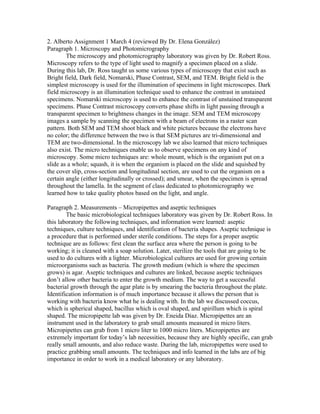
Alberto Assignment 1
- 1. 2. Alberto Assignment 1 March 4 (reviewed By Dr. Elena González) Paragraph 1. Microscopy and Photomicrography The microscopy and photomicrography laboratory was given by Dr. Robert Ross. Microscopy refers to the type of light used to magnify a specimen placed on a slide. During this lab, Dr. Ross taught us some various types of microscopy that exist such as Bright field, Dark field, Nomarski, Phase Contrast, SEM, and TEM. Bright field is the simplest microscopy is used for the illumination of specimens in light microscopes. Dark field microscopy is an illumination technique used to enhance the contrast in unstained specimens. Nomarski microscopy is used to enhance the contrast of unstained transparent specimens. Phase Contrast microscopy converts phase shifts in light passing through a transparent specimen to brightness changes in the image. SEM and TEM microscopy images a sample by scanning the specimen with a beam of electrons in a raster scan pattern. Both SEM and TEM shoot black and white pictures because the electrons have no color; the difference between the two is that SEM pictures are tri-dimensional and TEM are two-dimensional. In the microscopy lab we also learned that micro techniques also exist. The micro techniques enable us to observe specimens on any kind of microscopy. Some micro techniques are: whole mount, which is the organism put on a slide as a whole; squash, it is when the organism is placed on the slide and squished by the cover slip, cross-section and longitudinal section, are used to cut the organism on a certain angle (either longitudinally or crossed); and smear, when the specimen is spread throughout the lamella. In the segment of class dedicated to photomicrography we learned how to take quality photos based on the light, and angle. Paragraph 2. Measurements – Micropipettes and aseptic techniques The basic microbiological techniques laboratory was given by Dr. Robert Ross. In this laboratory the following techniques, and information were learned: aseptic techniques, culture techniques, and identification of bacteria shapes. Aseptic technique is a procedure that is performed under sterile conditions. The steps for a proper aseptic technique are as follows: first clean the surface area where the person is going to be working; it is cleaned with a soap solution. Later, sterilize the tools that are going to be used to do cultures with a lighter. Microbiological cultures are used for growing certain microorganisms such as bacteria. The growth medium (which is where the specimen grows) is agar. Aseptic techniques and cultures are linked, because aseptic techniques don’t allow other bacteria to enter the growth medium. The way to get a successful bacterial growth through the agar plate is by smearing the bacteria throughout the plate. Identification information is of much importance because it allows the person that is working with bacteria know what he is dealing with. In the lab we discussed coccus, which is spherical shaped, bacillus which is oval shaped, and spirillum which is spiral shaped. The micropipette lab was given by Dr. Eneida Díaz. Micropipettes are an instrument used in the laboratory to grab small amounts measured in micro liters. Micropipettes can grab from 1 micro liter to 1000 micro liters. Micropipettes are extremely important for today’s lab necessities, because they are highly specific, can grab really small amounts, and also reduce waste. During the lab, micropipettes were used to practice grabbing small amounts. The techniques and info learned in the labs are of big importance in order to work in a medical laboratory or any laboratory.
- 2. Paragraph 3. Workshop UNC – From DNA to Protein This workshop was given by UNC (University of North Carolina in Chapel Hill) and lasted 3 days. In this workshop old concepts like DNA, protein, RNA, electrophoresis were reviewed and also learned new concepts and techniques like how to extract our own DNA, what were oncogenes, and what was translational medicine. The first day of the workshop we learned about the speakers, from where are they and in what they were doing research; also it was discussed what was translational medicine, which is an area of research that focuses its efforts to carry scientific knowledge “from bench to bedside” (research which focuses on getting knowledge on how to better health). Also on the same day, some basic cancer information was discussed, and we extracted our own DNA from saliva. On the next day, we talked more about the basis of cancer, started talking of DNA, and the importance of the genetic code. The activity that was carried out in the second day was an electrophoresis of some particular cases and see which one had the oncogene, which is a gene that has the potential of having or causing cancer; the case that my group had did not have the oncogene. The third and final day we talked about what were proteins, they’re synthesis, what did they do, and how to detect them. The activities done during the third day were an electrophoresis of proteins and we played Jeopardy in order to see which team had learned more; my team ended in second place. It was a really good experience, and also it motivated me to keep pursuing a research opportunity.